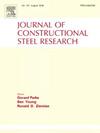Seismic performance of an innovative cold-formed thin-walled steel–timber composite beam-column joint
IF 4
2区 工程技术
Q1 CONSTRUCTION & BUILDING TECHNOLOGY
引用次数: 0
Abstract
Fast-growing timber has a short growth cycle, wide distribution, and abundant reserves, making it suitable for extensive application in building structures. However, due to its low strength, numerous defects, and high dispersion, it is not suitable for direct use as a structural material. Based on the ideology of improving the mechanical properties of fast-growing timber using cold-formed thin-walled steel, this paper proposes an innovative cold-formed thin-walled steel–fast-growing timber composite beam-column joint. Pseudo-static tests are conducted on 6 joints to study their failure modes, stiffness degradation, strength degradation, ductility and energy dissipation. The results show that the addition of stiffener rib to the joint can increase the positive and negative load-bearing capacities of the joint by 65.06 % and 94.04 %, respectively. The hysteretic response analysis and parametric analysis of the joints are conducted using ABAQUS finite element software. The results indicate that increasing the length of the stiffener rib, the diameter of the screws, and the thickness of the L-shaped steel are effective measures to enhance the seismic performance of the joints. The simplified spring unit model of the joint is established using the component method to calculate the initial rotational stiffness of the joint. Based on different failure modes of the joints, the calculation method for the flexural bearing capacity of the joints is established. The theoretical results can reflect the mechanical performance of the joints, providing a reliable design basis and reference for the design and application of the joints.
一种新型冷弯薄壁钢木组合梁-柱节点的抗震性能
速生材具有生长周期短、分布广、储量丰富等特点,适合在建筑结构中广泛应用。然而,由于其强度低,缺陷多,分散性高,不适合直接用作结构材料。基于利用冷弯薄壁钢改善速生木材力学性能的思想,提出了一种创新的冷弯薄壁钢-速生木材组合梁-柱节点。对6个节点进行了拟静力试验,研究了节点的破坏模式、刚度退化、强度退化、延性和耗能。结果表明:节点加劲肋可使节点的正、负承载能力分别提高65.06%和94.04%;采用ABAQUS有限元软件对节点进行了滞回响应分析和参数化分析。结果表明,增加加劲肋长度、螺钉直径和l型钢厚度是提高节点抗震性能的有效措施。采用分量法建立了关节的简化弹簧单元模型,计算了关节的初始转动刚度。根据节点的不同破坏模式,建立了节点抗弯承载力的计算方法。理论研究结果能够反映节点的力学性能,为节点的设计和应用提供可靠的设计依据和参考。
本文章由计算机程序翻译,如有差异,请以英文原文为准。
求助全文
约1分钟内获得全文
求助全文
来源期刊

Journal of Constructional Steel Research
工程技术-工程:土木
CiteScore
7.90
自引率
19.50%
发文量
550
审稿时长
46 days
期刊介绍:
The Journal of Constructional Steel Research provides an international forum for the presentation and discussion of the latest developments in structural steel research and their applications. It is aimed not only at researchers but also at those likely to be most affected by research results, i.e. designers and fabricators. Original papers of a high standard dealing with all aspects of steel research including theoretical and experimental research on elements, assemblages, connection and material properties are considered for publication.
 求助内容:
求助内容: 应助结果提醒方式:
应助结果提醒方式:


